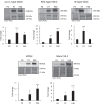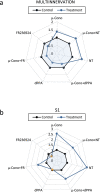Involvement of the Voltage-Gated Calcium Channels L- P/Q- and N-Types in Synapse Elimination During Neuromuscular Junction Development
- PMID: 35474562
- PMCID: PMC9167222
- DOI: 10.1007/s12035-022-02818-2
Involvement of the Voltage-Gated Calcium Channels L- P/Q- and N-Types in Synapse Elimination During Neuromuscular Junction Development
Abstract
During the nervous system development, synapses are initially overproduced. In the neuromuscular junction (NMJ) however, competition between several motor nerve terminals and the synapses they made ends with the maturation of only one axon. The competitive signaling between axons is mediated by the differential activity-dependent release of the neurotransmitter ACh, co-transmitters, and neurotrophic factors. A multiple metabotropic receptor-driven downstream balance between PKA and PKC isoforms modulates the phosphorylation of targets involved in transmitter release and nerve terminal stability. Previously, we observed in the weakest endings on the polyinnervated NMJ that M1 mAChR receptors reduce ACh release through the PKC pathway coupled to an excess of Ca2+ inflow through P/Q- N- and L-type voltage-gated calcium channels (VGCC). This signaling would contribute to the elimination of this nerve terminal. Here, we investigate the involvement of the P/Q-, N-, and L-subtype channels in transgenic B6.Cg-Tg (Thy1-YFP)16-Jrs/J mice during synapse elimination. Then, the axon number and postsynaptic receptor cluster morphologic maturation were evaluated. The results show that both L- and P/Q-type VGCC (but not the N-type) are equally involved in synapse elimination. Their normal function favors supernumerary axonal loss by jointly enhancing intracellular calcium [Ca2+]i. The block of these VGCCs or [Ca2+]i i sequestration results in the same delay of axonal loss as the cPKCβI and nPKCε isoform block or PKA activation. The specific block of the muscle cell's contraction with μ-conotoxin GIIIB also delays synapse maturation, and thus, a retrograde influence from the postsynaptic site regulating the presynaptic CaV1.3 may contribute to the synapse elimination.
Keywords: Axonal competition; Motor endplate; Postnatal synapse elimination; Protein kinases; VGCC.
© 2022. The Author(s).
Conflict of interest statement
The authors declare no competing interests.
Figures





Similar articles
-
Opposed Actions of PKA Isozymes (RI and RII) and PKC Isoforms (cPKCβI and nPKCε) in Neuromuscular Developmental Synapse Elimination.Cells. 2019 Oct 23;8(11):1304. doi: 10.3390/cells8111304. Cells. 2019. PMID: 31652775 Free PMC article.
-
Presynaptic muscarinic acetylcholine autoreceptors (M1, M2 and M4 subtypes), adenosine receptors (A1 and A2A) and tropomyosin-related kinase B receptor (TrkB) modulate the developmental synapse elimination process at the neuromuscular junction.Mol Brain. 2016 Jun 23;9(1):67. doi: 10.1186/s13041-016-0248-9. Mol Brain. 2016. PMID: 27339059 Free PMC article.
-
Brain-derived neurotrophic factor signaling in the neuromuscular junction during developmental axonal competition and synapse elimination.Neural Regen Res. 2025 Feb 1;20(2):394-401. doi: 10.4103/1673-5374.391314. Epub 2023 Dec 21. Neural Regen Res. 2025. PMID: 38819042 Free PMC article.
-
Presynaptic Membrane Receptors Modulate ACh Release, Axonal Competition and Synapse Elimination during Neuromuscular Junction Development.Front Mol Neurosci. 2017 May 16;10:132. doi: 10.3389/fnmol.2017.00132. eCollection 2017. Front Mol Neurosci. 2017. PMID: 28559796 Free PMC article. Review.
-
Calcium channels involved in neurotransmitter release at adult, neonatal and P/Q-type deficient neuromuscular junctions (Review).Mol Membr Biol. 2002 Oct-Dec;19(4):293-300. doi: 10.1080/0968768021000035087. Mol Membr Biol. 2002. PMID: 12512776 Review.
Cited by
-
Dendritic Spines: Synaptogenesis and Synaptic Pruning for the Developmental Organization of Brain Circuits.Adv Neurobiol. 2023;34:143-221. doi: 10.1007/978-3-031-36159-3_4. Adv Neurobiol. 2023. PMID: 37962796
-
Pioneering pain management with botulinum toxin type A: From anti-inflammation to regenerative therapies.Heliyon. 2025 Jan 28;11(4):e42350. doi: 10.1016/j.heliyon.2025.e42350. eCollection 2025 Feb 28. Heliyon. 2025. PMID: 40028584 Free PMC article. Review.
-
Thy1-YFP: an effective tool for single cell tracing from neuronal progenitors to mature functionally active neurons.Cell Death Discov. 2025 Jan 22;11(1):18. doi: 10.1038/s41420-025-02297-z. Cell Death Discov. 2025. PMID: 39843432 Free PMC article.
-
Regulation of pain neurotransmitters and chondrocytes metabolism mediated by voltage-gated ion channels: A narrative review.Heliyon. 2023 Jul 5;9(7):e17989. doi: 10.1016/j.heliyon.2023.e17989. eCollection 2023 Jul. Heliyon. 2023. PMID: 37501995 Free PMC article. Review.
-
Calcium channels in anesthesia management: A molecular and clinical review.Mol Pain. 2025 Jan-Dec;21:17448069251343417. doi: 10.1177/17448069251343417. Epub 2025 May 10. Mol Pain. 2025. PMID: 40346957 Free PMC article. Review.
References
-
- Nadal L, Garcia N, Hurtado E et al (2016) Presynaptic muscarinic acetylcholine autoreceptors (M1, M2 and M4 subtypes), adenosine receptors (A1 and A2A) and tropomyosin-related kinase B receptor (TrkB) modulate the developmental synapse elimination process at the neuromuscular junction. Mol Brain 9. 10.1186/s13041-016-0248-9 - PMC - PubMed
MeSH terms
Substances
Grants and funding
LinkOut - more resources
Full Text Sources
Research Materials
Miscellaneous

